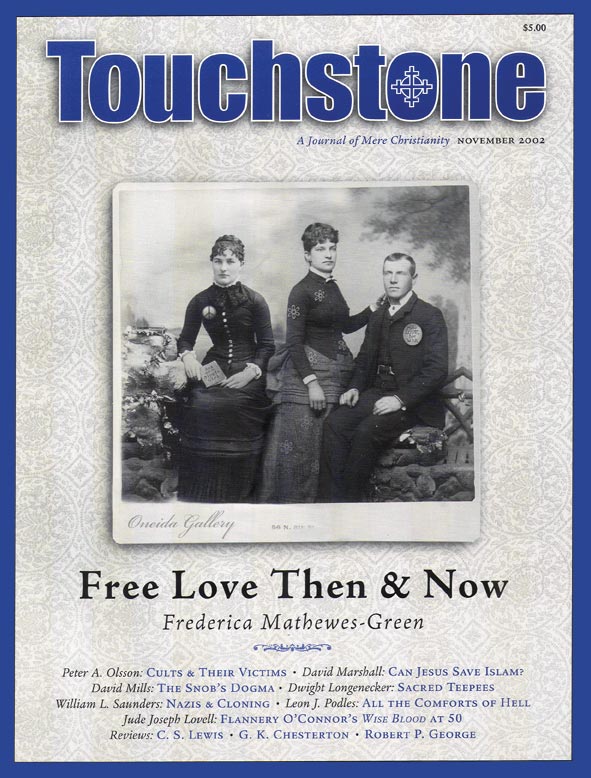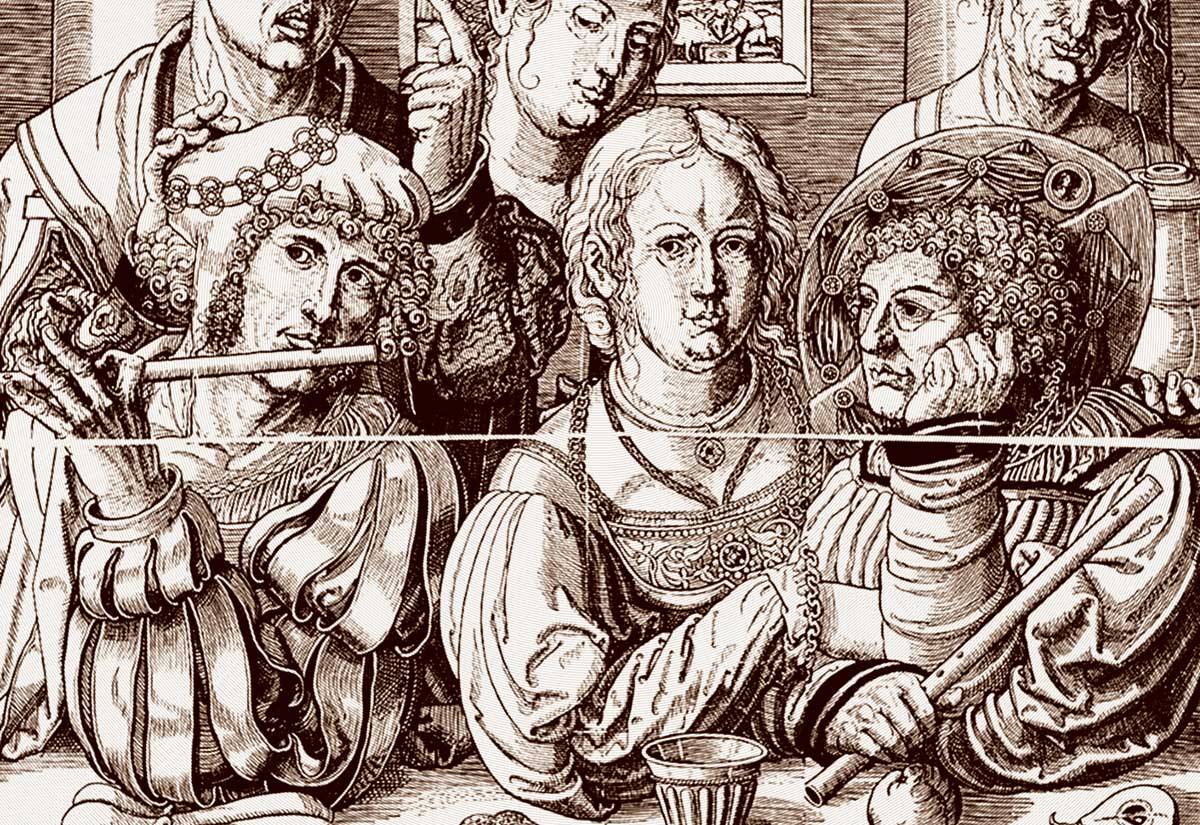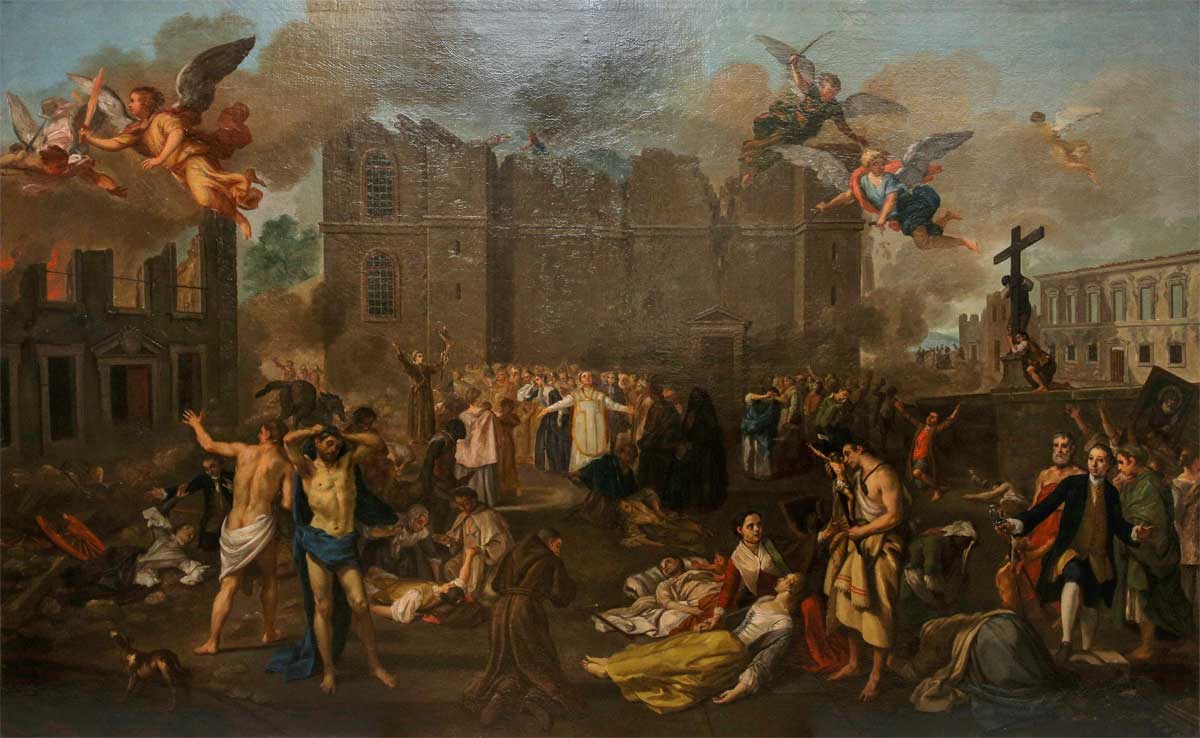The Ragged Figure
Jude Joseph Lovell on the 50th Anniversary of Flannery O’Connor’s Wise Blood
Just over fifty years ago, on May 15, 1952, a compact, alarmingly powerful first novel called Wise Blood was published with minimal fanfare by Harcourt, Brace and Company. The general public’s response to this bizarre fable about an outcast soldier in the Deep South who becomes an obsessive proponent of salvation without Jesus Christ was tepid. Of those few readers who did notice the novel, many of them came away from it baffled, perhaps even angered, at the urgently anti-Christian rages of its protagonist, the unforgettable Hazel Motes. In purely commercial terms, the novel was rejected.
Writers, however—particularly those with a Catholic or Christian worldview—immediately heard a mighty new voice sounding off in the wilderness. Novelist and critic Caroline Gordon famously wrote that the author’s “picture of the modern world” was “literally terrifying.” When she suggested to the well-known Catholic writer J. F. Powers that Wise Blood brought Franz Kafka to her mind, Powers, who had also read the book, disagreed. Kafka, he wrote back, was “much too young and tender to play in that league.”
The tiny hint of fear—whether competitive or existential—that can be detected in the response of these two established Catholic writers to Wise Blood is enough in itself to elicit admiration for the book’s effect. To earn respect of this caliber from one’s colleagues would seem to be the result of a seasoned, worldly, perhaps embittered old novelist’s finest effort, the product of a long life and career spent fine-tuning a sharp, dispassionate perspective on this world. But when the novelist in question was in fact a 26-year-old Catholic woman from rural Georgia, single, soft-spoken and physically fragile, the elements are in place for one of the most extraordinary and unlikely mysteries in the history of American letters.
Never in American literature had a vision of such penetrating insight and brutal honesty sprung forth from so improbable a provenance. Even the endless flow of critical studies and the unceasing application of such descriptive terms as “freakish,” “grotesque,” and “Southern Gothic” have failed to answer adequately the questions of who Flannery O’Connor really was and what she was really trying to say. We can still only speculate about what forces—divine in origin, perhaps—shaped the mind of a sickly girl from Georgia into a witty, cerebral artist who wrote with uncommon poise and power.
A Haunting Novel
What is it, then, that is so haunting about Wise Blood? The first indication is the sheer strangeness of its plot. A young, irritable war veteran, Hazel Motes, scarred in both literal and figurative terms, returns from the battlefield to his home state of Georgia to do things he “never [has] done before.” These turn out to be knocking around town for a while, following and fiercely debating a corrupt preacher and his manipulative daughter, and attempting to establish a church of his own called The Holy Church of Christ Without Christ, in which “the blind don’t see and the lame don’t walk and what’s dead stays that way.”
After numerous attempts to sow his angry and bitter seeds fail to yield any harvest, and a variety of comical encounters with another hapless exile named Enoch Emery fail to produce a “new jesus” [sic] on which to build his “church,” Hazel takes decisive action. He deliberately blinds himself, plunges headlong into the elements, and ends up dead, having been neglected by himself, the world, and, seemingly, God.
The first time I read the book, I was a soldier living in the state of Georgia, in my mid-twenties, and working on my understanding of those same three things: God, the world at large, and myself. I can remember being truly baffled by Wise Blood and asking myself where at any point in the book could I find the slightest evidence of love, forgiveness, Catholicism, or even of the woman herself who wrote the thing. I was convinced that these were not there: The novel had simply been misinterpreted.
What I could not grasp at the time was that the truths I was looking for, and that Flannery O’Connor was expressing in her novel, could be found only in the negative spaces. They were like expressions hidden on the reverse of the two-sided masks with which her characters were disguised. In the case of Hazel Motes, the more he attempts to conceal the presence of Christ within him with scowls and invective, the more his true identity as a child of God is recognized by other characters.
When, early in the novel, a taxi driver tells Hazel that his black hat makes him look like a preacher, Hazel denies it with venom. Yet the driver replies: “It ain’t only the hat. It’s a look in your face somewheres.” Later, the corrupt preacher Asa Hawks tells Hazel with a snicker, “some preacher has left his mark on you.” Hawks is later revealed to be a false witness, yet even he can identify the light of Christ in Hazel Motes. In Wise Blood, Christ lingers, unseen and yet recognizable, just behind the ineffective facade of human expression and behavior.
I entirely missed such telling moments as these upon first reading Wise Blood. I found only death and the antithesis of hope. However, something about the way Hazel Motes died, heaped in the back seat of a police car after being pulled from a ditch, hinted that the story had a second dimension. Some of the terror and potency that struck O’Connor’s colleagues with such force began to gnaw at me as well.
An Elusive Design
Three years later, I was no longer a soldier; I was a graduate student working in a bookstore to make ends meet while pursuing a degree in creative writing. One day, while cracking open cardboard boxes of books with which to restock the shelves, I came across a fresh supply of Wise Blood. The cover depicted a heart wrapped in barbed wire: a striking visual metaphor that seized my attention anew.
I began to flip through the novel and skim its pages. It was not until I spotted an absolutely unforgettable description of Jesus that I knew without question that I had to read the book again and get to the core of O’Connor’s elusive design. That description referred to Jesus as “the ragged figure who moves from tree to tree in the back of [Hazel’s] mind.”
It has been impossible for me to fully eliminate this image of our Redeemer from my consciousness. It shook me. What an extraordinary accomplishment that was, in purely artistic terms, for the author who conceived it. Most young writers would suffer fifty years of misinterpretation and near-poverty if they knew they would one day produce a single image like this, which grasped people’s consciousness with an iron grip and never let go.
So, like the earnest young apprentice to the literary greats that I was aspiring to be, I delved deeply into O’Connor, rereading Wise Blood and other works by and about her. Eventually I began to unravel some of the mystery. O’Connor used blunt dialogue, symbolism, intense imagery, violence, and fanatical characters as a means of getting the attention of her readers and directing it to fundamental Christian realities. Tough times, for O’Connor, demanded tough talk.
“The novelist with Christian concerns,” she wrote in an essay called “The Fiction Writer and His Country,” “will find in modern life distortions which are repugnant to him, and his problem will be to make these appear as distortions to an audience which is used to seeing them as natural; and he may well be forced to take ever more violent means to get his vision across to this hostile audience.”
These “violent means” can hardly be more apparent than in the self-abusive actions that Hazel Motes engages in throughout his life. In one of the novel’s flashbacks, we witness a young Hazel filling his shoes with rocks and stones in order to accommodate what he believes is Jesus’ desire for his suffering: “He thought, That ought to satisfy him.” Later, in the pivotal gesture of the novel, Hazel physically blinds himself. His landlady, a woman with the symbolic name of Mrs. Flood, tries in vain to comprehend the meaning of his behavior:
“Mind your business,” he said rudely. “You can’t see.”
The landlady continued to chew very slowly. “Do you think, Mr. Motes,” she said hoarsely, “that when you’re dead, you’re blind?”
“I hope so,” he said after a minute.
“Why?” she asked, staring at him.
After a while he said, “If there’s no bottom in your eyes, they hold more.”
The landlady stared for a long time, seeing nothing at all.
O’Connor’s clear implication is that it is the blinded Hazel, rather than the seemingly normal landlady, who has finally acquired a vision of the truth.
O’Connor’s Wisdom
Once I discovered that O’Connor wrote her stories and novels from this perspective, I was first of all simply astonished at the wisdom of this young woman. Her ability to detach herself from her own environment in the Deep South and perceive the pattern of a broader cultural malaise was truly remarkable. “The woods are full of regional writers,” she wrote, “and it is the great horror of every serious Southern writer to become one of them.” Rather than write about the South itself, O’Connor created characters whose uniquely Southern traits help to illustrate truths that transcend geographical borders.
Slowly, with some persistence, I began to make at least some sense of O’Connor’s uncommon methods in Wise Blood. Reading the novel a second time, I found the characters themselves no less repellent, if sometimes hilarious in their maniacal rants and behavior. Hazel Motes is a short-fused unbeliever who mutilates himself. Enoch Emery is, in O’Connor’s own term, a “moron.” Asa Hawks is a twisted impostor in preacher’s clothing, with no more belief than Hazel.
These are intentionally exaggerated figures, whose comic and pathetic mishaps are meant to point towards the work of grace in this world. O’Connor could clearly discern where the battle lines were being drawn between Christian and secular forces in postwar America, and she understood that the use of eclectic and memorable characters helped to emphasize this distinction. Therefore, it is no surprise that the protagonists of her stories and novels frequently become unknowing agents of greater purposes.
For Hazel, it is his very insistence on unbelief that accomplishes this so effectively. “[Hazel’s] nihilism leads him back to the fact of his Redemption,” O’Connor wrote to a colleague. “Which is what he would have liked so much to get away from.” Hazel Motes follows his bitter heart to a fatal extreme. He wants to believe that he is capable of redeeming himself, and that he has no need to rely on the power of grace. But in the end he has the honesty to recognize that he has been overwhelmed. The fact that he blinds himself indicates that he is cognizant of his own defeat.
I began to understand that an emphatic statement was being made. It was coming in the form of a series of mishaps, absurd comic foibles, fits of anger, and, ultimately, the categorical failure to avoid a preordained end, all happening at the expense of a confused and unfortunate young man. Now I was starting to hear the message, and it seemed to be stated boldly and loudly: Christians have good reason to be hopeful, because the grace of Jesus Christ is dogged. It will follow us, and it will not give up.
This explained why, as I found out later, O’Connor insisted that Wise Blood was “a very hopeful book.” Throughout the novel, Hazel Motes actively seeks to rid himself of Jesus’ presence, both within and without. And he repeatedly fails to do so. It begins early, with his Pentecostal preacher grandfather, who had “ridden over three counties with Jesus hidden in his head like a stinger” and who forced Hazel at a young age to sit before his congregations while he preached. He would go on at length about how “that boy had been redeemed and Jesus wasn’t going to leave him ever. Jesus would never let him forget he was redeemed. What did the sinner think there was to be gained? Jesus would have him in the end!”
This turns out to be the truth, in an exaggerated way. Later in life, as Hazel wanders through the small town searching for a place to establish his Holy Church of Christ Without Christ, the false prophet Asa Hawks, who causes Hazel such turmoil and irritation, mercilessly drives home the point: “Listen boy, you can’t run away from Jesus. Jesus is a fact.”
At another point, again in a flashback, Hazel Motes’s mother reprimands him for sinful behavior by telling him, “Jesus died to redeem you.” Hazel’s reply to this statement is, “I never ast him.” Yet Jesus comes on, ever forward in pursuit of his own child, continuously, throughout the story. The ragged figure continues to follow him, and it is Hazel’s awareness of this Presence that finally brings him to his end.
O’Connor’s Integrity
It was a negative, some might even say a twisted method by which she made her point. But Flannery O’Connor had the artistic integrity to admit that making the point itself was more important to her than the feelings of her readers. “The writer is only free when he can tell the reader to go jump in a lake. You want . . . to get what you have to show across to him, but whether he likes it or not is no concern of the writer.”
A writer who grasps this is something like a serial criminal on the loose, leaving no sign of a trail by which he can be caught. He has great power, and it’s open season for him to use it. He has nothing to lose. Other writers knew this, and this is why they respected, and perhaps even envied or feared, Flannery O’Connor.
We should be grateful today that this gifted novelist lived and worked among us and possessed what Thomas Merton called “fidelity to the truth.” Wise Blood reminds us that the Hound of Heaven will never lose our scent. While we drift ever further into the shadow of our own darkness, the Son of Man follows closely behind us with great concern, waiting to unleash his overpowering love at our moment of surrender. This message resonates after fifty years as powerfully as ever in Wise Blood, and it may have more relevance today than at any other time before.
Jude Joseph Lovell was born in Chicago and graduated from Xavier University (Ohio) in 1992 with a B.A. in Communication Arts. From 1992 to 1996 he served as an officer in the United States Army. In January 2001, he received a Master of Fine Arts in Creative Writing from New School University in New York City. He lives in Hamilton, New Jersey.
subscription options
Order
Print/Online Subscription

Get six issues (one year) of Touchstone PLUS full online access including pdf downloads for only $39.95. That's only $3.34 per month!
Order
Online Only
Subscription

Get a one-year full-access subscription to the Touchstone online archives for only $19.95. That's only $1.66 per month!
bulk subscriptions
Order Touchstone subscriptions in bulk and save $10 per sub! Each subscription includes 6 issues of Touchstone plus full online access to touchstonemag.com—including archives, videos, and pdf downloads of recent issues for only $29.95 each! Great for churches or study groups.
Transactions will be processed on a secure server.
more from the online archives
calling all readers
Please Donate
"There are magazines worth reading but few worth saving . . . Touchstone is just such a magazine."
—Alice von Hildebrand
"Here we do not concede one square millimeter of territory to falsehood, folly, contemporary sentimentality, or fashion. We speak the truth, and let God be our judge. . . . Touchstone is the one committedly Christian conservative journal."
—Anthony Esolen, Touchstone senior editor









